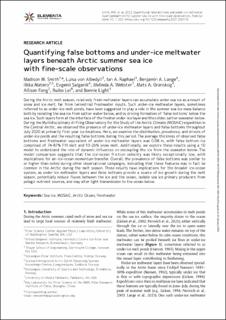| dc.contributor.author | Smith, Madison M. | |
| dc.contributor.author | von Albedyll, Louisa | |
| dc.contributor.author | Raphael, Ian A. | |
| dc.contributor.author | Lange, Benjamin | |
| dc.contributor.author | Matero, Ilkka | |
| dc.contributor.author | Salganik, Evgenii | |
| dc.contributor.author | Webster, Melinda | |
| dc.contributor.author | Granskog, Mats A. | |
| dc.contributor.author | Fong, Allison | |
| dc.contributor.author | Lei, Ruibo | |
| dc.contributor.author | Light, Bonnie | |
| dc.date.accessioned | 2023-02-02T09:01:09Z | |
| dc.date.available | 2023-02-02T09:01:09Z | |
| dc.date.created | 2022-07-19T10:18:49Z | |
| dc.date.issued | 2022 | |
| dc.identifier.citation | Elementa: Science of the Anthropocene. 2022, 10 (1), . | en_US |
| dc.identifier.issn | 2325-1026 | |
| dc.identifier.uri | https://hdl.handle.net/11250/3047897 | |
| dc.description.abstract | Kartlegging av ferskvannslag og dannelse av falsk bunnis under sjøisen ved sommarsmelting i sentrale Polhavet Sjøisen i Polhavet er i rask endring. Den er blitt mye tynnere i løpet av de siste tiårene, havet og atmosfæren er i endring, og dette påvirker det marine økosystemet i Polhavet. Klimaprosesser i Arktis er følgelig viktige for hele planeten, og polare prosesser er viktige elementer i klimamodeller. Dette var motivasjonen for ekspedisjonen «Multidisciplinary drifting Observatory for the Study of Arctic Climate» (MOSAiC) i 2019-2020, og målsetningen var å samle inn data om atmosfære, havis, hav og det marine økosystem, og koblete prosesser gjennom et helt år i det sentrale Polhavet. Norsk polarinstitutt deltok i ekspedisjonen med flere forskere støttet av prosjektet HAVOC finansiert av Forskningsrådet. Under issmelting på sommeren samles ofte smeltevann fra is og snø i tynne lag under isen som påvirker koblingen mellom hav og is. Dette bidrar til isdannelse midt på sommeren når mesteparten av isen smelter. Falsk bunnis dannes når det kalde ferskvannet møter enda kaldere saltvann under isen og danner en såkalt «false bottoms» på grensesnittet mellom ferskvann og saltvann. Det er lite forstått om utbredelsen av slike ferskvannslag og hvordan de påvirker sjøisen på sommeren. Under MOSAiC ble det gjennomført kartlegging av disse vannlagene i drivisen, og man fant at de befant seg oftere under tynnere første års is. Dette kan ha påvirkning på blant annet smelting av isen og for is assosierte planter og dyr, særskilt om det skjer enda mer smelting. Disse prosesser må dermed bli bedre representert i klimamodeller slik at endringer i havisen kan bedre forutsies i fremtiden. | en_US |
| dc.description.abstract | Quantifying false bottoms and under-ice meltwater layers beneath Arctic summer sea ice with fine-scale observations | en_US |
| dc.description.abstract | During the Arctic melt season, relatively fresh meltwater layers can accumulate under sea ice as a result of snow and ice melt, far from terrestrial freshwater inputs. Such under-ice meltwater layers, sometimes referred to as under-ice melt ponds, have been suggested to play a role in the summer sea ice mass balance both by isolating the sea ice from saltier water below, and by driving formation of ‘false bottoms’ below the sea ice. Such layers form at the interface of the fresher under-ice layer and the colder, saltier seawater below. During the Multidisciplinary drifting Observatory for the Study of the Arctic Climate (MOSAiC) expedition in the Central Arctic, we observed the presence of under-ice meltwater layers and false bottoms throughout July 2020 at primarily first-year ice locations. Here, we examine the distribution, prevalence, and drivers of under-ice ponds and the resulting false bottoms during this period. The average thickness of observed false bottoms and freshwater equivalent of under-ice meltwater layers was 0.08 m, with false bottom ice comprised of 74–87% FYI melt and 13–26% snow melt. Additionally, we explore these results using a 1D model to understand the role of dynamic influences on decoupling the ice from the seawater below. The model comparison suggests that the ice-ocean friction velocity was likely exceptionally low, with implications for air-ice-ocean momentum transfer. Overall, the prevalence of false bottoms was similar to or higher than noted during other observational campaigns, indicating that these features may in fact be common in the Arctic during the melt season. These results have implications for the broader ice-ocean system, as under-ice meltwater layers and false bottoms provide a source of ice growth during the melt season, potentially reduce fluxes between the ice and the ocean, isolate sea ice primary producers from pelagic nutrient sources, and may alter light transmission to the ocean below. | en_US |
| dc.language.iso | eng | en_US |
| dc.publisher | University of California Press | en_US |
| dc.rights | Navngivelse 4.0 Internasjonal | * |
| dc.rights.uri | http://creativecommons.org/licenses/by/4.0/deed.no | * |
| dc.subject | Sjøis | en_US |
| dc.subject | Sea ice | en_US |
| dc.subject | Arktis | en_US |
| dc.subject | Arctic | en_US |
| dc.subject | Polhavet | en_US |
| dc.subject | Arctic ocean | en_US |
| dc.title | Quantifying false bottoms and under-ice meltwater layers beneath Arctic summer sea ice with fine-scale observations | en_US |
| dc.title.alternative | Quantifying false bottoms and under-ice meltwater layers beneath Arctic summer sea ice with fine-scale observations | en_US |
| dc.type | Peer reviewed | en_US |
| dc.type | Journal article | en_US |
| dc.description.version | publishedVersion | en_US |
| dc.subject.nsi | VDP::Andre geofag: 469 | en_US |
| dc.subject.nsi | VDP::Other geosciences: 469 | en_US |
| dc.source.pagenumber | 19 | en_US |
| dc.source.volume | 10 | en_US |
| dc.source.journal | Elementa: Science of the Anthropocene | en_US |
| dc.source.issue | 1 | en_US |
| dc.identifier.doi | 10.1525/elementa.2021.000116 | |
| dc.identifier.cristin | 2038741 | |
| dc.relation.project | Norges forskningsråd: 280292 | en_US |
| dc.relation.project | Norges forskningsråd: 280531 | en_US |
| cristin.ispublished | true | |
| cristin.fulltext | original | |
| cristin.qualitycode | 1 | |

